Flexural Behavior of Post-Tensioned Concrete Beams with Multiple Internal Corroded Strands
Abstract
:1. Introduction
2. Flexural Tests on Corroded PC Beams
2.1. Fabrication of Test Specimens
2.2. Test Results
3. Residual Mechanical Properties of Corroded Strands
4. Flexural strength Evaluation of Corroded PC Beams
4.1. Approximation
| : | The stress of the corroded prestressing strand or tendon when is 0.003 |
| : | The ultimate stress of the most corroded prestressing strand in a tendon |
| : | The cross-sectional area of the gross strand-unit section |
| : | The coefficient according to the type of strand |
| : | The ratio between the depth of an equivalent rectangular concrete stress block and the neutral axis depth (=a/c) |
| : | The prestressing steel ratio |
| : | The cross-sectional area of the gross tendon-unit section |
| : | The depth of the tensile reinforcement |
| : | The depth of the prestressing strand |
| : | The tensile reinforcement index |
| ’: | The compression reinforcement index |
4.2. Strain Compatibility Using OpenSEES
5. Comparison and Discussion
5.1. Comparison of Evaluation Methods with Test Results
5.2. Comparison between the Methods Using Monte-Carlo Simulation
6. Conclusions
- (1)
- From the PC beam loading test, the corrosion of strands located close to the support did not have a significant influence on the global behavior. This was because of the lower flexural moment of the loading and sufficient bond strength between the strands and the surrounding concrete. However, when the beam had tendon-unit section loss of 9.49% in the middle of the span, the ultimate strength of the beam exhibited a 15.56% reduction after the rupture of the third wire.
- (2)
- Based on the tensile test results of the corroded strands, the ultimate properties of corroded strands were defined. Because the ultimate strain decreased sharply after section loss of 5%, the material models of the corroded strands were divided into two categories; the bi-linear material model and the brittle material model were used in the cases where the section loss was lower and higher than 5%, respectively.
- (3)
- Strength evaluations of the corroded PC beams according to the approximation and the strain-compatibility methods using OpenSEES were compared to the test results. The strain compatibility method exhibited relatively higher accuracy with a difference of 1.59% and 0.14% for non-corroded and corroded PC beams, respectively. When PC beams had multiple strands, the strain compatibility method was more practical to apply separately, using different corrosion properties.
- (4)
- According to the Monte-Carlo simulation, the difference between the evaluated flexural strength based on both methods increased with the level of section loss when the section loss exceeded 5%. Therefore, a decision-making flow chart was proposed, which suggests the use of the strain compatibility method only after a section loss of 5%.
Author Contributions
Funding
Acknowledgments
Conflicts of Interest
References
- VDOT. Evaluation of Grout and Strands at 13 Tendon Locations and Selected Vertical PT Bars at Fixed Piers: Maintenance and Repair Using Corrosion Mitigation Systems (Final Report); Virginia Department of Transportation: Richmond, VA, USA, 2013.
- Trejo, D.; Hueste, M.B.D.; Gardoni, P.; Pillai, R.G.; Reinschmidt, K.; Im, S.B.; Kataria, S.; Hurlebaus, S.; Gamble, M.; Ngo, T.T. Effect of Voids in Grouted Post-Tesioned Concrete Bridge Construction: Electrochemical testing and Reliability Assessment; Texas Transportation Institute: Austin, TX, USA, 2009. [Google Scholar]
- Carsana, M.; Bertolini, L. Corrosion failure of post-tensioning tendons in alkaline and chloride-free segregated grout: A case study. Struct. Infrastruct. Eng. 2015, 11, 402–411. [Google Scholar] [CrossRef]
- Pape, T.M.; Melchers, R.E. Performance of 45-year-old corroded prestressed concrete beams. Proc. Inst. Civ. Eng. Struct. Build. 2013, 166, 547–559. [Google Scholar] [CrossRef] [Green Version]
- Moawad, M.; El-Karmoty, H.; Zanaty, A.E. Behavior of corroded bonded fully prestressed and conventional concrete beams. HBRC J. 2018, 14, 137–149. [Google Scholar] [CrossRef] [Green Version]
- Malumbela, G.; Alexander, M.; Moyo, P. Steel corrosion on RC structures under sustained service loads—A critical review. Eng. Struct. 2009, 31, 2518–2525. [Google Scholar] [CrossRef]
- Campione, G.; Cannella, F.; Minafo, G. A simple model for the calculation of the axial load-carrying capacity of corroded RC columns. Mater. Struct. 2015, 49, 1935–1945. [Google Scholar]
- Rinaldi, Z.; Imperatore, S.; Valente, C. Experimental evaluation of the flexural behavior of corroded P/C beams. Constr. Build. Mater. 2010, 24, 2267–2278. [Google Scholar] [CrossRef]
- Wang, L.; Zhang, X.; Zhang, J.; Ma, Y.; Xiang, Y.; Liu, Y. Effect of insufficient grouting and strand corrosion on flexural behavior of PC beams. Constr. Build. Mater. 2014, 53, 213–224. [Google Scholar] [CrossRef]
- Zhang, X.; Wang, L.; Zhang, J.; Liu, Y. Corrosion-induced flexural behavior degradation of locally ungrouted post-tensioned concrete beams. Constr. Build. Mater. 2017, 134, 7–17. [Google Scholar] [CrossRef]
- Reis, R.A. Corrosion Evaluation and Tensile Results of Selected Post-Tensioning Strands at the SFOBB Skyway Seismic Replacement Project; California Department of Transportation: Sacramento, CA, USA, 2007. [Google Scholar]
- Lu, Z.H.; Li, F.; Zhao, Y.G. An Investigation of Degradation of Mechanical Behaviour of Prestressing Strands Subjected to Chloride Attacking. In Proceedings of the International Conference on Durability of Concrete Structures, Shenzhen University, Shenzhen, China, 30 June–1 July 2016. [Google Scholar]
- Wu, X.; Li, H. Effect of Strain Level on Corrosion of Prestressing Steel Strands. In Proceedings of the International Association for Bridge and Structural Engineering, Zurich, Switzerland, 21–23 September 2016; pp. 292–299. [Google Scholar]
- Hartt, W.H.; Lee, S.K. Projecting Corrosion-Induced Bridge Tendon Failure Resulting from Deficient Grout: Part I–Model Development and Example Results. Corrosion 2016, 72, 991–998. [Google Scholar] [CrossRef]
- Yoo, C.H.; Park, Y.C.; Kim, H.K. Modeling Corrosion Progress of Steel Wires in External Tendons. J. Bridg. Eng. 2018, 23, 04018098. [Google Scholar] [CrossRef]
- Jeon, C.H.; Lon, S.; Shim, C.S. Equivalent material model of corroded prestressing steel strand. J. Mater. Res. Technol. 2019, 8, 2450–2460. [Google Scholar] [CrossRef]
- Lee, J.B.; Lee, Y.J.; Shim, C.S. Probabilistic prediction of mechanical characteristics of corroded strands. Eng. Struct. 2020, 203, 203. [Google Scholar] [CrossRef]
- Jeon, C.H.; Nguyen, C.D.; Shim, C.S. Assessment of Mechanical Properties of Corroded Prestressing Strands. Appl. Sci. 2020, 10, 4055. [Google Scholar] [CrossRef]
- Korean Standards Association. KS D 7002: Uncoated Stress-Relieved Steel Wires and Strands for Prestressed Concrete; Korean Standards Association: Seoul, Korea, 2011. (In Korean)
- Lee, B.S.; Koh, K.T.; Ismail, M.A.; Ryu, H.S.; Kwon, S.J. Corrosion and Strength Behaviors in Prestressed Tendon under Various Tensile Stress and Impressed Current Conditions. Adv. Mater. Sci. Eng. 2017, 2017, 1–7. [Google Scholar] [CrossRef] [Green Version]
- Li, F.; Yuan, Y. Effects of corrosion on bond behavior between steel strand and concrete. Constr. Build. Mater. 2013, 38, 413–422. [Google Scholar] [CrossRef]
- Kaba, K.; Watanabe, S.; Yoshikawa, T.; Saito, S. Experimental study on the effect of PC tendon rupture on load-carrying capacity of PC girder. J. Struct. Eng. A. 2020, 66A, 725–732. [Google Scholar]
- Wang, L.; Zhang, X.; Zhang, J.; Dai, L.; Liu, Y. Failure analysis of corroded PC beams under flexural load considering bond degradation. Eng. Fail. Anal. 2017, 73, 11–24. [Google Scholar] [CrossRef]
- Korean Standards Association. KS D 3504: Steel Bars for Concrete Reinforcement; Korean Standards Association: Seoul, Korea, 2011. (In Korean)
- Coronelli, D.; Castel, A.; Vu, N.A.; Fancois, R. Corroded post-tensioned beams with bonded tendons and wire failure. Eng. Struct. 2009, 31, 1687–1697. [Google Scholar] [CrossRef]
- ASTM A416/A416M-18. Standard Specification for Low-Relaxation, Seven-Wire Steel Strand for Prestressed Concrete; ASTM International: West Conshohocken, PA, USA, 2018. [Google Scholar]
- ACI Committee 318. Building Code Requirements for Structural Concrete (ACI 318-14); American Concrete Institute: Farmington Hills, MI, USA, 2015. [Google Scholar]
- McKenna, F.; Fenves, G.L. Open System for Earthquake Engineering Simulation (OpenSees); Pacific Earthquake Engineering Research Center (PEER), University of California: Berkeley, CA, USA, 2004. [Google Scholar]
- Kent, D.C.; Park, D. Flexural members with confined concrete. J. Struct. Div. 1971, 97, 1969–1990. [Google Scholar]
- British Standards Institution. Eurocode 2: Design of Concrete Structures; British Standard; BSI: London, UK, 2008. [Google Scholar]
- Ferreira, R.M. Probability-Based Durability Analysis of Concrete Structure in Marine Environment. Ph.D. Thesis, Department of Civil Engineering, School of Engineering, University of Minho, Braga, Portugal, 2004. [Google Scholar]

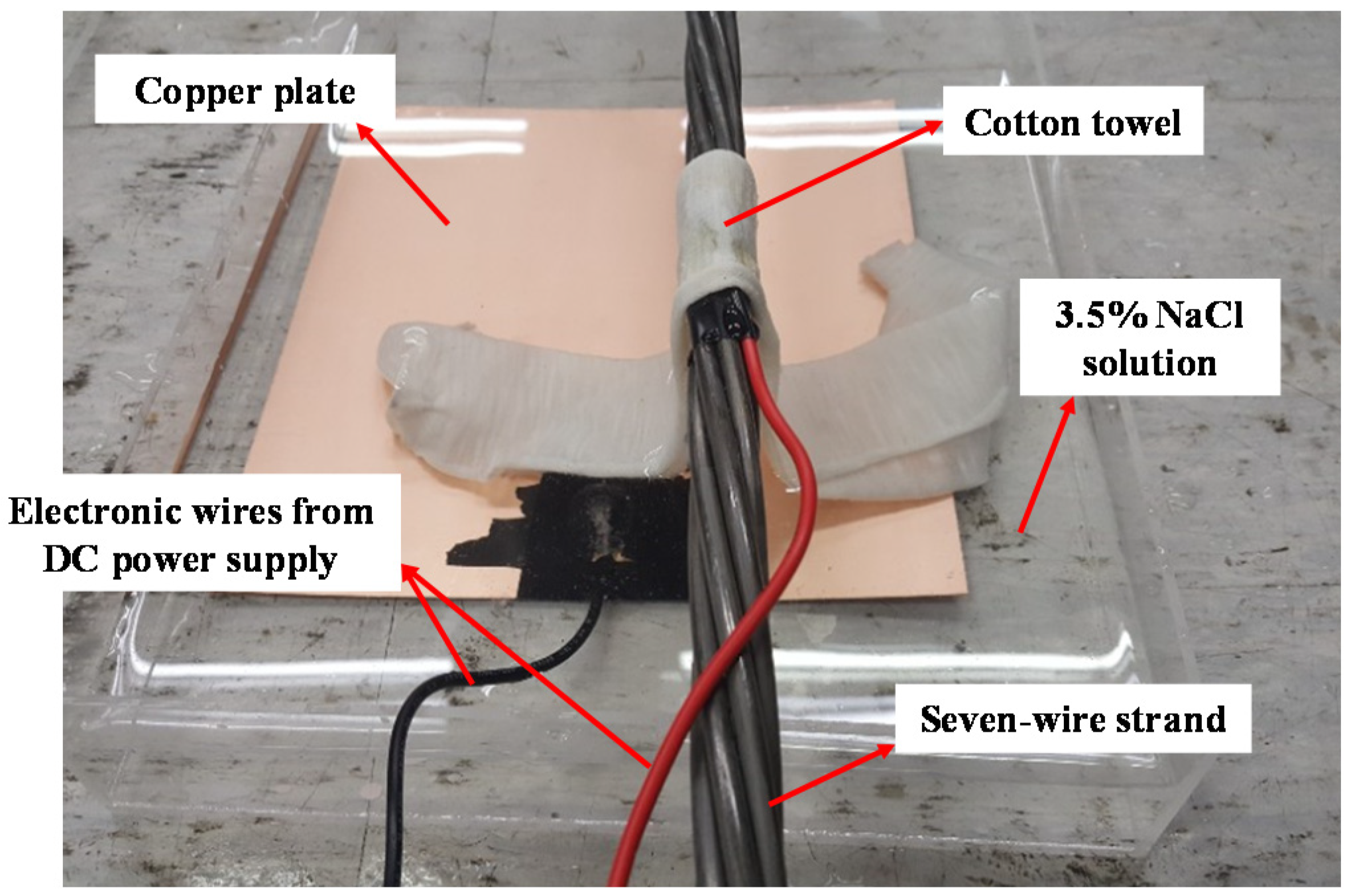


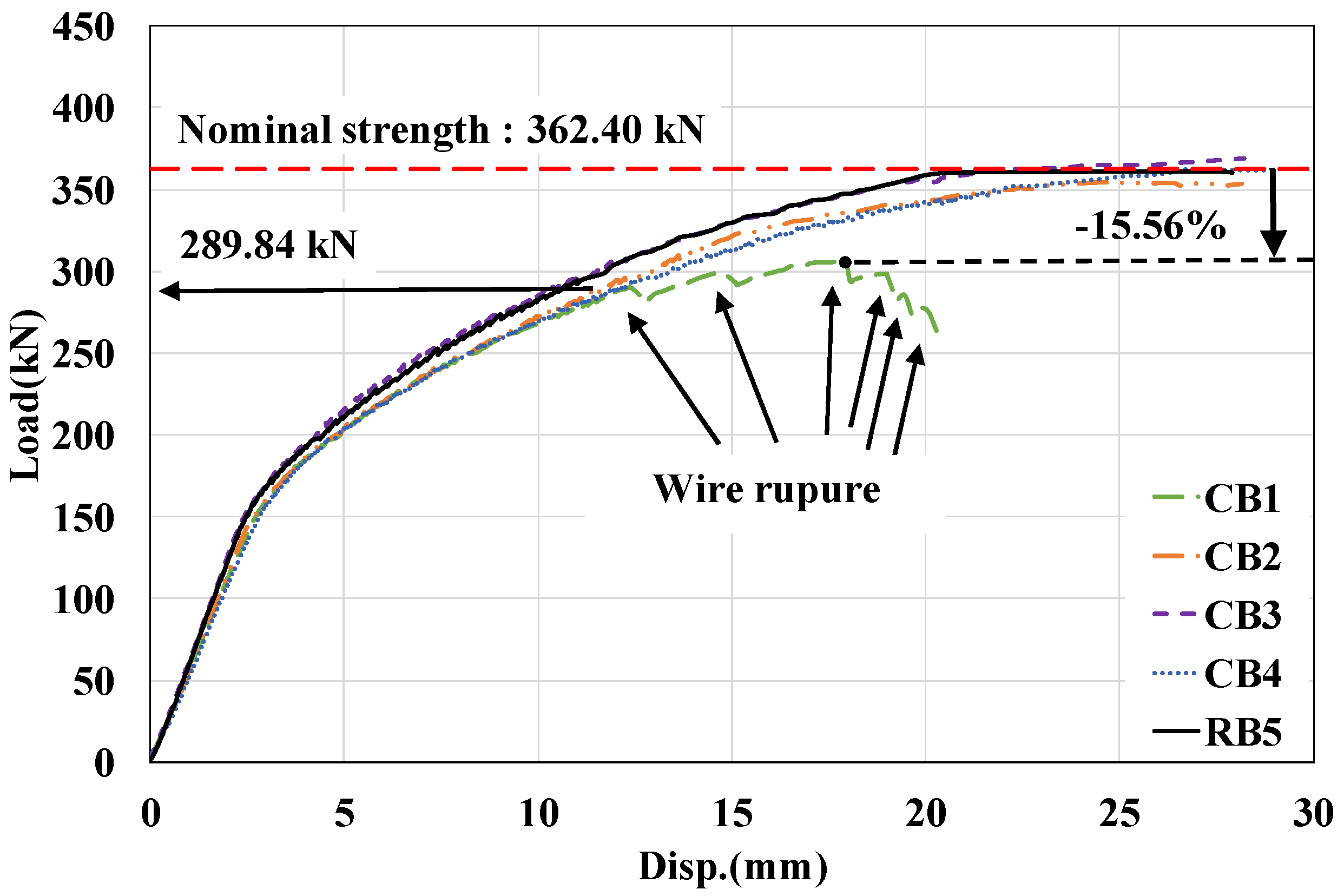
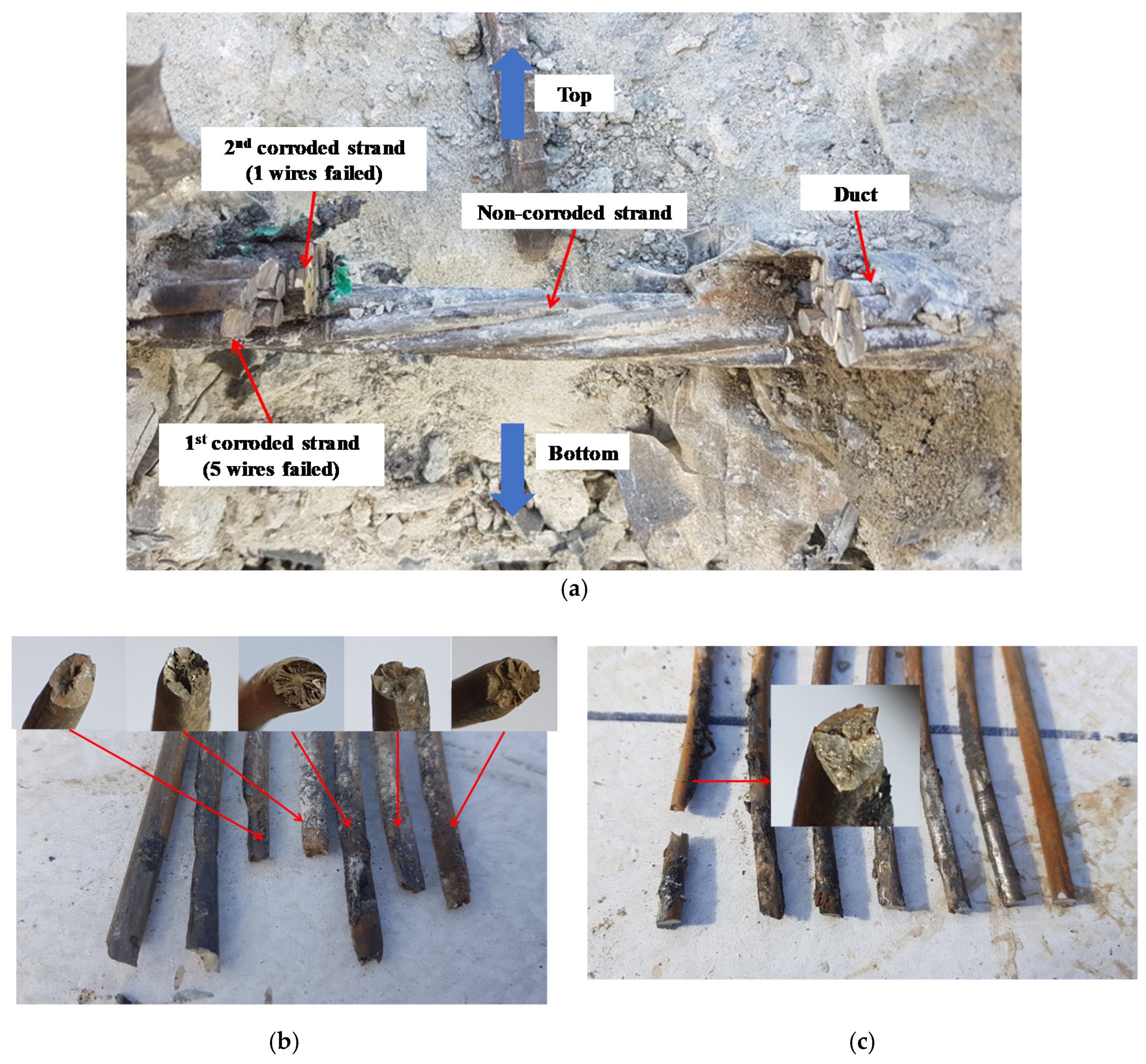

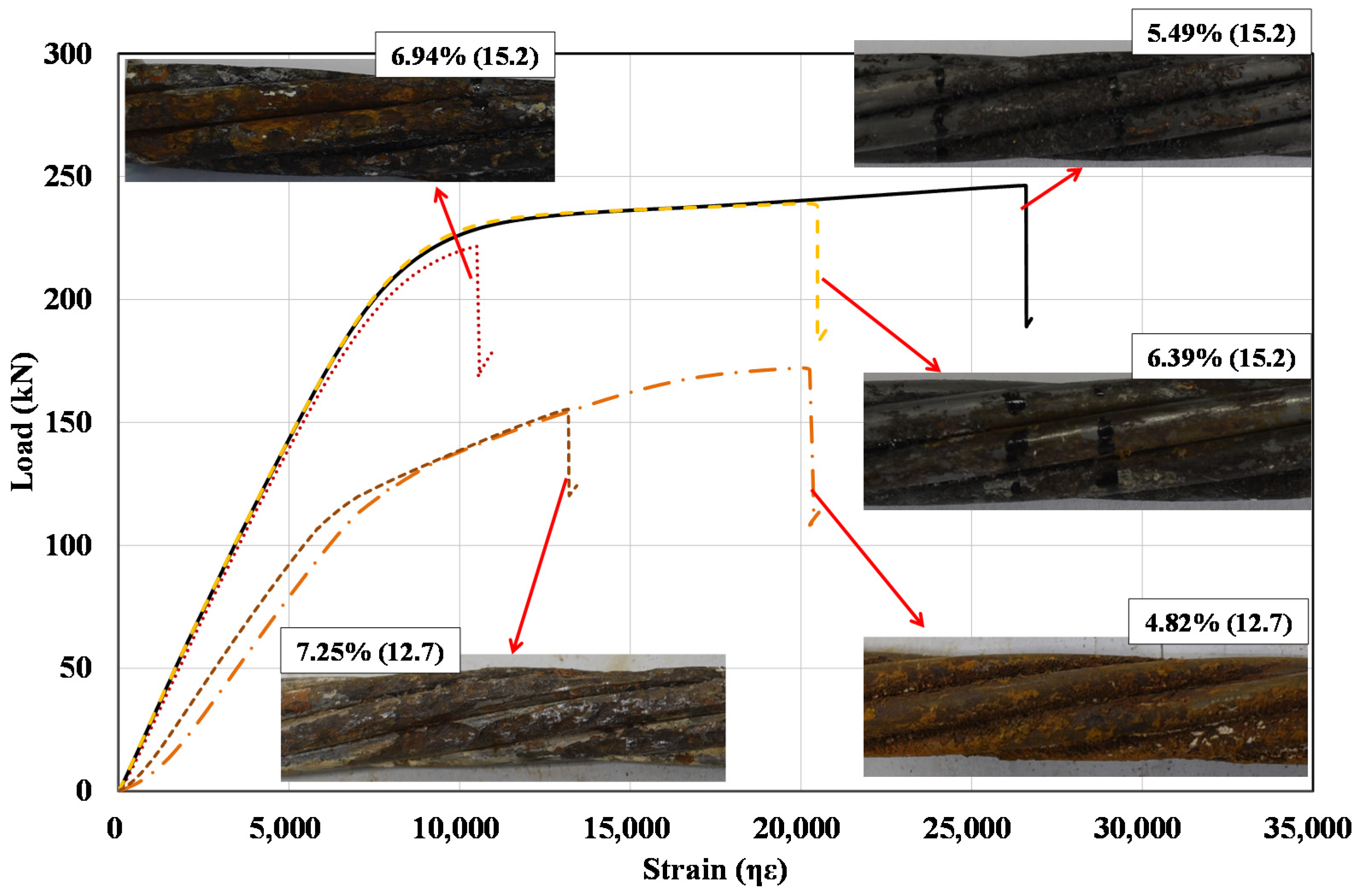

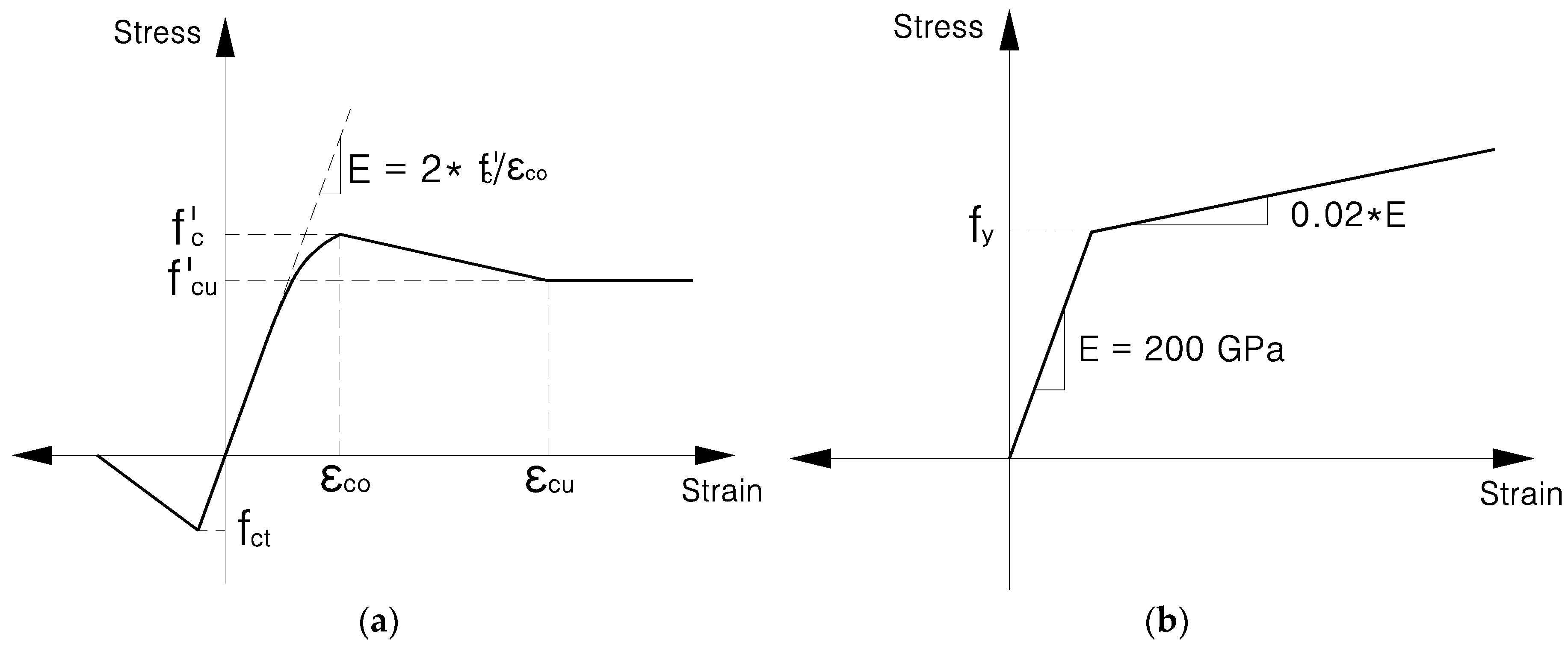

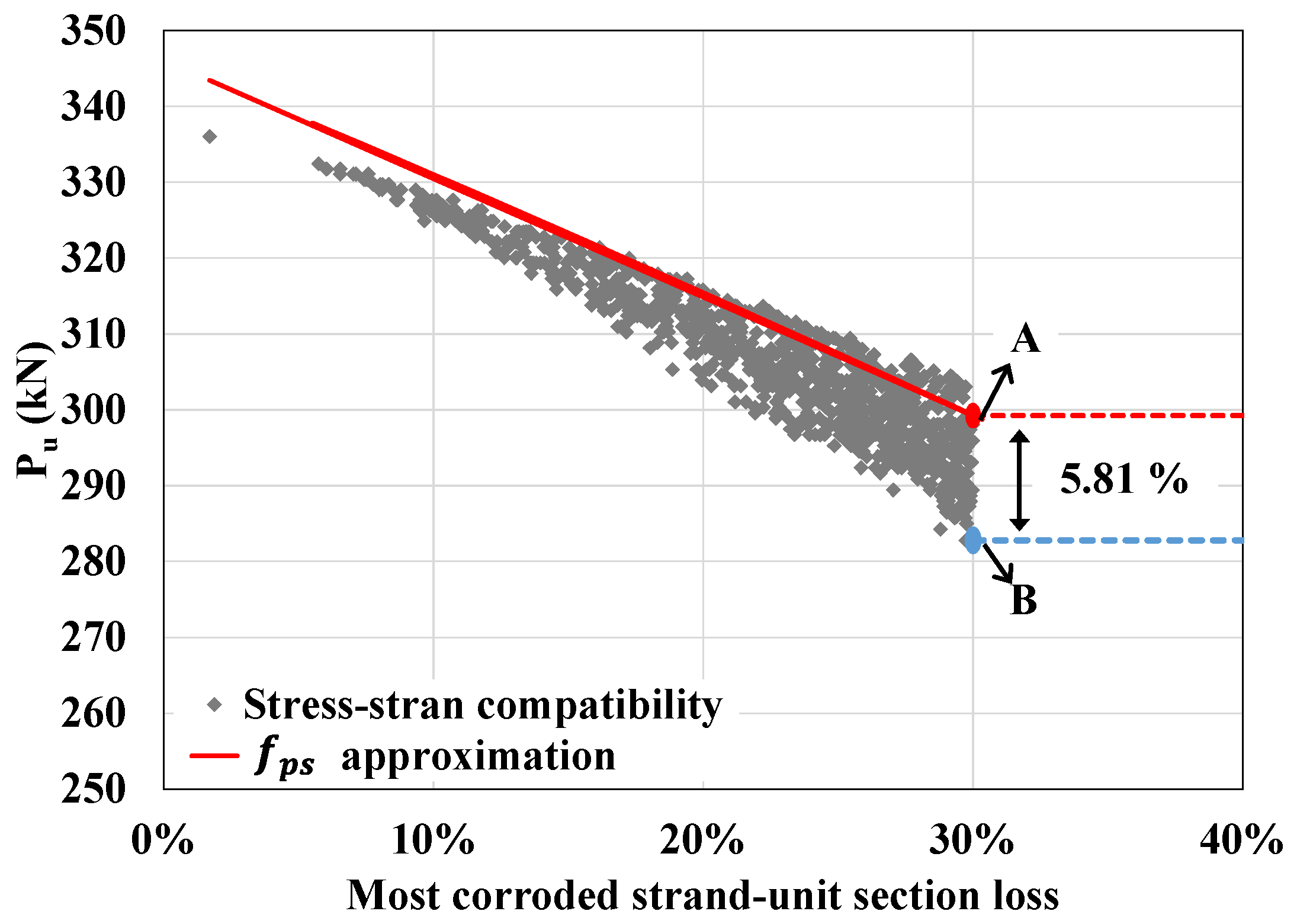
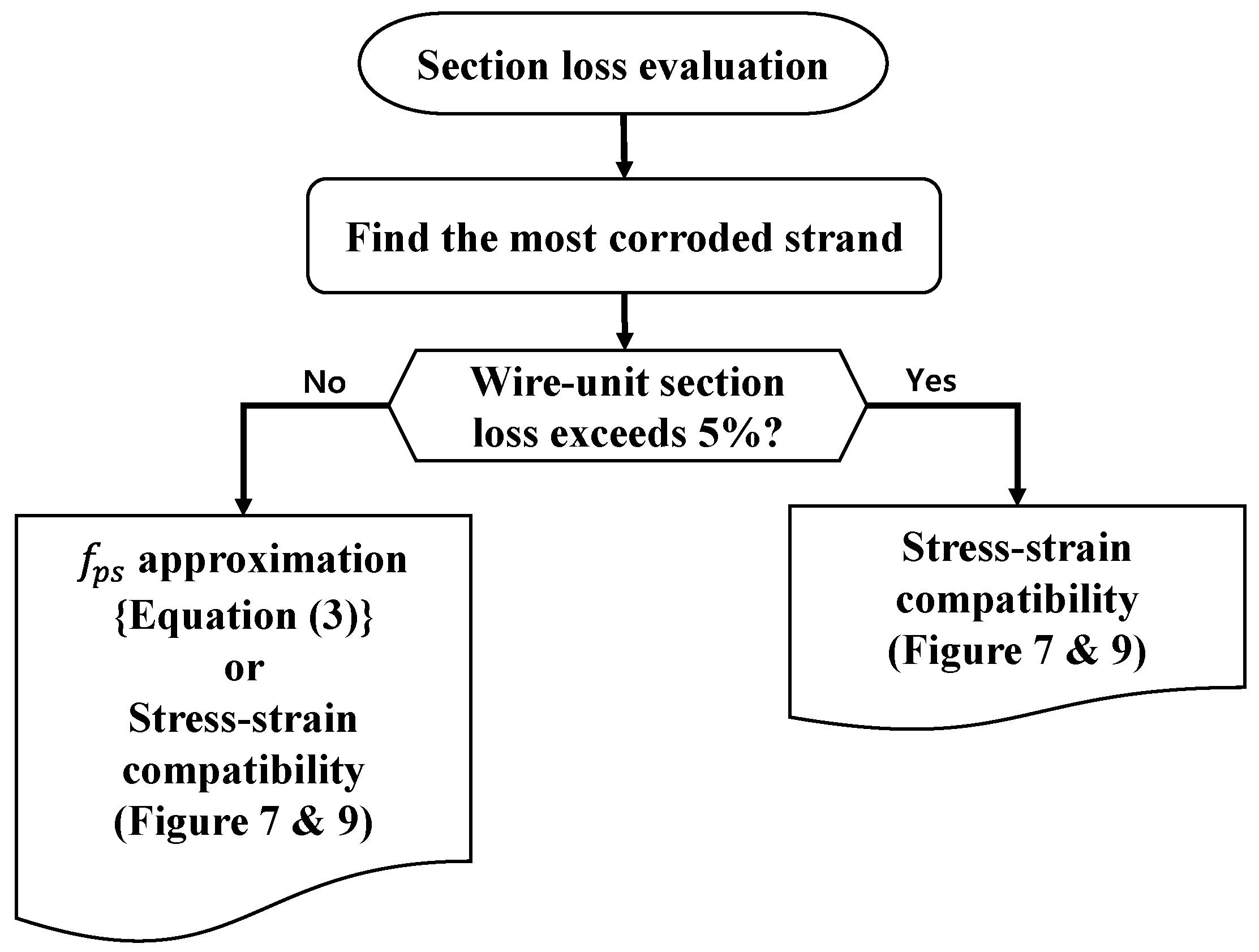
| ID | # of Corroded Strands | Corrosion Location | Wire-Unit Section Loss | Strand-Unit Section Loss | Tendon-Unit Section Loss |
|---|---|---|---|---|---|
| CB1 | 2 | Midspan | 30.22% (6596 mm) | 14.26% (1003 mm) | 9.49% (571 mm) |
| CB2 | 3 | 300 mm from support | 22.54% (2665 mm) | 9.51% (573 mm) | 8.84% (529 mm) |
| CB3 | 2 | 29.02% (5725 mm) | 10.71% (660 mm) | 6.89% (420 mm) | |
| CB4 | 3 | 19.55% (1872 mm) | 6.94% (423 mm) | 6.80% (416 mm) | |
| RB5 | 0 | - | - | - | - |
| Rebars (KS D 3504) | Concrete (Cylinder Test) | Strands (Tensile Test) |
|---|---|---|
| : 400 MPa : 560 MPa : 200 GPa | : 44.07 MPa | : 1652 MPa : 1883 MPa : 195 GPa : 0.0752 |
| ID | Cracking Load (kN) | Maximum Load (kN) | Failure Mode |
|---|---|---|---|
| CB1 | 130 | 289.84 (when 1st wire failed) | Compressive concrete crush after rupture of six wires |
| CB2 | 140 | 354.27 | Compressive concrete crush |
| CB3 | 140 | 367.75 | Compressive concrete crush |
| CB4 | 140 | 362.11 | Compressive concrete crush |
| RB5 | 140 | 361.13 | Compressive concrete crush |
| Strand | Wires | Section Loss | Strand | Wires | Section Loss |
|---|---|---|---|---|---|
| 1st strand | Core wire | - | 2nd strand | Core wire | - |
| 1 | 30.22% | 1 | 18.45% | ||
| 2 | 13.03% | 2 | 0.00% | ||
| 3 | 11.66% | 3 | 17.26% | ||
| 4 | 16.52% | 4 | 13.83% | ||
| 5 | 3.09% | 5 | 29.77% | ||
| 6 | 27.59% | 6 | 23.11% |
| 3.5 MPa | 44.07 MPa | 0.85×= 37.46 MPa | 0.00238 | 0.0035 |
| ID | Maximum Loads of... | ||
|---|---|---|---|
| Experiment | Strain Compatibility (Difference) | Approximation (Difference) | |
| CB1 | 289.84 kN (when 1st wire failure) | 290.27 kN (0.14%) | 299.22 kN (3.23%) |
| CB2 | 339.08 kN | 346.48 kN (−4.39% from nominal strength) | 363.66 kN (0.30% from nominal strength) |
| CB3 | 352.07 kN | ||
| CB4 | 336.63 kN | ||
| RB5 | 352.07 kN | ||
Publisher’s Note: MDPI stays neutral with regard to jurisdictional claims in published maps and institutional affiliations. |
© 2020 by the authors. Licensee MDPI, Basel, Switzerland. This article is an open access article distributed under the terms and conditions of the Creative Commons Attribution (CC BY) license (http://creativecommons.org/licenses/by/4.0/).
Share and Cite
Jeon, C.-H.; Shim, C.-S. Flexural Behavior of Post-Tensioned Concrete Beams with Multiple Internal Corroded Strands. Appl. Sci. 2020, 10, 7994. https://doi.org/10.3390/app10227994
Jeon C-H, Shim C-S. Flexural Behavior of Post-Tensioned Concrete Beams with Multiple Internal Corroded Strands. Applied Sciences. 2020; 10(22):7994. https://doi.org/10.3390/app10227994
Chicago/Turabian StyleJeon, Chi-Ho, and Chang-Su Shim. 2020. "Flexural Behavior of Post-Tensioned Concrete Beams with Multiple Internal Corroded Strands" Applied Sciences 10, no. 22: 7994. https://doi.org/10.3390/app10227994





